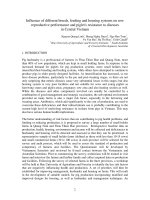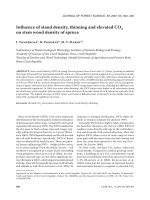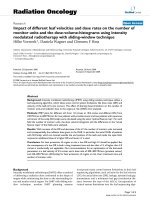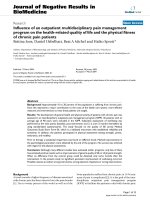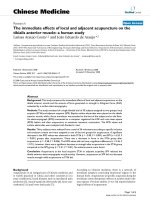Influence of Confined Optical Phonons and Laser Radiation on the Radioelectric Effect in a Cylindrical Semiconductor Quantum Wire with Parabolic Potential
Bạn đang xem bản rút gọn của tài liệu. Xem và tải ngay bản đầy đủ của tài liệu tại đây (272.5 KB, 6 trang )
<span class='text_page_counter'>(1)</span><div class='page_container' data-page=1>
1
Influence of Confined Optical Phonons and Laser Radiation
on the Radioelectric Effect in a Cylindrical Semiconductor
Quantum Wire with Parabolic Potential
Nguyen Quang Bau
*, Cao Thi Vi Ba, Do Tuan Long
<i> Faculty of Physics, VNU University of Science, 334 Nguyen Trai, Hanoi, Vietnam </i>
Received 08 July 2017
Revised 30 August 2017; Accepted 15 September 2017
<b>Abstract: Based on the quantum kinetic equation method, the influence of confined optical </b>
phonons and laser radiation on the Radioelectric effect in a cylindrical semiconductor quantum
wire with parabolic potential subjected to a dc electric field and a linearly polarized
electromagnetic wave has been theoretically studied. The obtained analytical expression of the
Radioelectric field (REF) depends on frequencies and amplitudes of the external electromagnetic
waves, the quantum wire parameters, the temperature of the system, and especially the quantum
<i>numbers (n and m) which characterize the phonon confinement. Numerical calculations for the </i>
GaAs/GaAsAl quantum wire show the strongly impact of the confined optical phonons as well as
the laser radiation on the REF magnitude and posture. The REF also has more resonance peaks in
comparison with that in case of bulk phonon.
<i>Keywords: Confined optical phonon, laser radiation, Radioelectric field, Cylindrical quantum </i>
wire, quantum kinetic equation.
<b>1. Introduction</b>
The Radioelectric effect in semiconductor systems has attracted many interests in recent years. It is
known that with the propagation electromagnetic wave (EMW), free carriers absorb both energy and
EMW momentum, thereby electrons are generated with directed motion, and in this direction a
Radioelectric field (REF) arises under opened circuit conditions [1, 2]. The longitudinal and the
transverse REF has been theoretically calculated in the bulk semiconductor [1] and in the superlattices
[3], the Radioelectric current has been shown to be considered and be certainly observable by
experiments [4, 5]. Since the confined modes of phonons were experimentally observed in
low-dimensional semiconductors systems [6, 7], there have been many paper dealing with the impact of
confined phonon on kinetic properites of them, such as the cyclotron-phonon resonance in
semiconducting quantum well [8], the additional resonant peak of the absorption coefficient of strong
EMW in doped superlattices due to confined phonon [9], the dispersion of confined LO phonons in
_______
<sub>Corresponding author. Tel.: 84- 9133488020. </sub>
Email:
</div>
<span class='text_page_counter'>(2)</span><div class='page_container' data-page=2>
quantum well [10], the frequency separation of confined AlAs LO modes has found in superlattices
[11], the carrier capture processes in semiconductor superlattices due to emission of confined phonons
[12]. Also, the additional strong EMW has been shown to enhance the nonlinear properties of these
structures [9, 13]. Hence, the Radioelectric effect is much more interesting in low-dimensional
semiconductor system under the influence of confined phonons and laser radiation. In [13], the REF in
doped superlattices has multiple resonant peaks and its magnitude increases as the increasing of
phonon confinement. In this paper, to show the differences of the Radioelectric effect when changing
the material confinement potential, we consider a cylindrical semiconductor quantum wire (CQW)
with parabolic potential subjected to a linearly polarized electromagnetic field and varying laser
radiation. This leads to change the electron wave function and energy, the matrix element of confined
electron – confined optical phonon interaction as well as the Hamiltonian of the system, thus, creating
new properties of the REF in a CQW. We predict the extra resonant peaks and the raising in
magnitude of the REF in a CQW under the influence of confined phonons and the laser radiation.
The article is organized as follows: in the section 2 we present the confinement of electrons and
optical phonons in a CQW. We have derived the analytical expression for the REF by using the
quantum kinetic equation method in the section 3. Numerical results and discussion for the
GaAs/AlAs cylindrical quantum wire are given in the section 4. And the final section shows remarks
and conclusions.
<b>2. The confinement of electrons and phonons in a cylindrical semiconductor quantum wire </b>
Consider a cylindrical quantum wire with parabolic potential <i>V</i> <i>1m<sub>e</sub></i> <i><sub>1</sub>2R2</i>
<i>2</i>
subjected to a linearly
polarized electromagnetic field: <i><sub>E(t)</sub></i><i><sub>E e</sub></i>
<i>i t</i> <i><sub>e</sub>i t</i>
<sub>, </sub> <i><sub>B t</sub></i>
<i>1</i> <i><sub>n,E t</sub></i>
<i>c</i>
and a laser radiation
<i>F t</i> <i>F sin</i><i>t</i>. Under the influence of the material confinement potential, the motion of carriers is
<i>restricted in x, y direction and free in the z one. So, the wave function of an electron and its discrete </i>
energy now becomes [14]:
<i>ij</i> <i>ik zz</i>
<i>l , j</i> <i>l , j</i>
<i>0</i>
<i>1</i>
<i>r, ,z</i> <i>e e</i> <i>r</i>
<i>V</i>
, where
<i>r2</i> <i>2/ 2</i>
<i>j</i> <i>j</i>
<i>2</i> <i>2</i>
<i>l , j</i> <i>l</i>
<i>2l !</i>
<i>r</i> <i>e</i> <i>r</i> <i>L</i> <i>r</i> <i>,</i>
<i>l</i> <i>j !</i>
<sub></sub>
(1)
<i>2</i> <i>2z</i>
<i>l , j</i> <i>z</i> <i>1</i>
<i>e</i>
<i>p</i>
<i>p</i> <i>2l</i> <i>j</i> <i>1 ,</i>
<i>2m</i>
(2)
where <i>p ,m is the wave vector and the effective mass of an electron, R being the radius of the <sub>z</sub></i> <i><sub>e</sub></i>
<i>CQW, l</i><i>1,2,3,... and j</i> <i>0, 1, 2,...</i> being the quantum numbers characterizing the electron
confinement, <i>me</i><i>1</i> <sub> and </sub> <i>j</i>
<i>l</i>
<i>L</i> is the generalized Laguerre polynomial.
When phonons are confined in a CQW, the wave vector and frequency of them are given by
[14,15]:
<i>m,n</i> <i>z</i>
<i>q</i> <i>q</i> <i>,q</i> , <i>q<sub>m ,n</sub></i> <i>xm ,n</i>
<i>R</i>
,
<i>z</i>
<i>2</i> <i>2</i> <i>2</i> <i>2</i> <i>2</i>
<i>m,n,q</i> <i>0</i> <i>qm,n</i> <i>qz</i>
</div>
<span class='text_page_counter'>(3)</span><div class='page_container' data-page=3>
where is the velocity parameter, <i>x<sub>m ,n</sub> is the nth zero of the mth order Bessel function, and </i>
<i>m,n</i><i>1,2,3,...</i> being the quantum numbers characterizing the phonon confinement.
Also, the matrix element for confined electron – confined optical phonon interaction in the CQW
now becomes [14]
<i>z</i> <i>z</i>
<i>m,n</i> <i>m,n</i>
<i>l , j ,l', j',q</i> <i>m,n,q</i> <i>l , j ,l', j'</i>
<i>D</i> <i>C</i> <i>I</i> where:
<i>z</i>
<i>2</i>
<i>2</i> <i><sub>0</sub></i>
<i>m,n ,q</i> <i>2</i> <i>2</i> <i>2</i>
<i>0</i> <i>m,n</i> <i>z</i>
<i>0</i> <i>0</i> <i>m 1</i> <i>m,n</i>
<i>2 e</i> <i>1</i> <i>1</i> <i>1</i>
<i>C</i> <i>,</i>
<i>q</i> <i>q</i>
<i>V J</i> <i>x</i>
<sub></sub> <sub></sub>
<sub></sub> <sub></sub>
(4)
<i>R</i>
<i>m,n</i> <i>*</i>
<i>l , j ,l', j'</i> <i>2</i> <i>m</i> <i>m,n</i> <i>l', j'</i> <i>l , j</i>
<i>0</i>
<i>2</i> <i>r</i>
<i>I</i> <i>J</i> <i>x</i> <i>r</i> <i>r rdr.</i>
<i>R</i> <i>R</i>
<sub></sub> <sub></sub>
(5)Through equations (1-5), it has been seen that the CQW with new material confinement potential
gives the different electron wave function and energy. In addition, the contribution of confined phonon
could enhance the probability of electron scattering. As a result, the Radioelectric effect in a CWQ
under the influence of confined optical phonon and laser radiation should be studied carefully to find
out the new properties.
<b>3. The radioelectric field in a cylindrical semiconductor quantum wire with parabolic potential </b>
<b>under the influence of confined optical phonons and laser radiation </b>
The effect of confined optical phonons and the laser radiation modify the Hamiltonian of the
confined electrons – confined optical phonons system in the CQW. This leads the quantum kinetic
equation for electron distribution now become:
<sub> </sub>
<sub> </sub>
<i>z</i> <i>z</i>
<i>z</i>
<i>z</i>
<i>2</i> <i>2</i>
<i>l , j , p</i> <i>l , j , p</i> <i>m,n</i> <i>2</i>
<i>0</i> <i>c</i> <i>z</i> <i>m,n ,q</i> <i>l , j ,l', j'</i> <i>s</i> <i>2</i> <i>z</i>
<i>l', j',</i> <i>s</i>
<i>z</i> <i>e</i>
<i>m,n ,q</i>
<i>f</i> <i>t</i> <i>f</i> <i>t</i> <i>2</i> <i>eF</i>
<i>eE t</i> <i>eE</i> <i>p ,h t</i> <i>,</i> <i>C</i> <i>I</i> <i>J</i> <i>,q</i>
<i>t</i> <i>p</i> <i>m</i>
<sub></sub> <sub></sub>
<sub></sub> <sub></sub> <sub></sub> <sub></sub>
<sub></sub> <sub></sub>
<sub></sub> <sub></sub>
<i>fl', j',pz</i><i>qz</i> <i>t</i> <i>Nm,n,qz</i> <i>1</i> <i>fl , j ,pz</i> <i>t Nm,n,qz</i> <i>l', j'</i> <i>pz</i> <i>qz</i> <i>l , j</i> <i>pz</i> <i>m,n,qz</i> <i>s</i>
<sub></sub> <sub></sub>
<i>fl', j',pz</i><i>qz</i> <i>t Nm,n,qz</i> <i>fl , j ,pz</i> <i>t</i> <i>Nm,n,qz</i> <i>1</i> <i>l', j'</i> <i>pz</i> <i>qz</i> <i>l , j</i> <i>pz</i> <i>m,n,qz</i> <i>s</i>
<sub></sub> <sub></sub> (6)
<i>where h</i><i>B / B</i> is the unit vector along the magnetic field, <i><sub>c</sub></i> <i>eB / m<sub>e</sub></i> and
<i>x</i> being theDirac delta function.
It has been seen that equation (6) contains new terms <i><sub>l , j</sub></i>, <i><sub>l', j'</sub></i>, <i>I<sub>l , j ,l', j'</sub>m,n</i> ,
<i>z</i>
<i>m,n ,q</i>
in comparison with
that in [13]. These terms characterize the effect of CQW confinement potential and the phonon
confinement. This leads to change the electron distribution function, the current density and the
Radioelectric field in a CQW.
<i>Let us consider that the electron gas is non-degenerate and limit the problem to the cases of s=-1, </i>
<i>0,1, meaning the processes with more than one photon are ignored. Suppose the linearly polarized </i>
<i>electromagnetic wave propagates along the x axis, E || Oz , B || Oy , F || Oz . After some manipulation, </i>
the expression for the longitudinal Radioelectric field <i>E<sub>0 x</sub></i> is obtained:
<i>2</i> <i>2</i>
<i>c</i>
<i>0 x</i> <i>2</i> <i>2</i> <i>2</i> <i>2</i>
<i>c</i>
<i>2</i> <i>1</i> <i>b</i>
<i>E</i> <i>1</i> <i>E,</i>
<i>1</i> <i>1</i> <i>a</i>
<sub></sub> <sub></sub>
</div>
<span class='text_page_counter'>(4)</span><div class='page_container' data-page=4>
where
<i><sub>F</sub></i> <i><sub>l , j</sub></i>
<i><sub>B</sub></i>
<i>1</i><i>l , j</i>
<i>a</i>
<i>exp</i><sub></sub> <sub></sub><i>,</i> <i>k T</i> <i>,</i> (8)
<i>2</i> <i>2</i>
<i>1</i>
<i>0</i>
<i>0</i> <i>1,0</i> <i>1,0</i> <i>1, 1</i> <i>1,1</i> <i>1, 1</i> <i>1,1</i>
<i>3 / 2</i> <i>2</i> <i>4</i>
<i>e</i> <i>0</i>
<i>2 e</i> <i>F</i> <i>1</i> <i>1</i>
<i>b</i> <i>exp</i> <i>1</i> <i>2b</i> <i>2b</i> <i>b</i> <i>b</i> <i>b</i> <i>b</i>
<i>2m</i>
<sub> </sub>
<sub></sub> <sub></sub> <sub></sub>
, (9)
<i>2</i>
<i>m,n</i>
<i>l , j ,l', j'</i> <i>F</i> <i>l , j</i> <i>1</i> <i>m,n</i> <i>0</i>
<i>m,n ,</i>
<i>l , j ,l', j'</i>
<i>b</i>
<i>I</i> <i>exp</i> <i>/ 2</i> <i>K</i> <i>K</i>
<i>m,nsgn</i> <i>K</i> <i>1</i>
<sub></sub>
,
here <i><sub>l', j'</sub></i><i><sub>l , j</sub></i> <i><sub>m,n</sub></i> , <i>l', j'</i> <i>1</i>
<i>2l'</i> <i>j'</i> <i>1</i>
, <i>l , j</i> <i>1</i>
<i>2l</i> <i>j</i> <i>1</i>
,<i>2</i> <i>2</i>
<i>m ,n</i>
<i>m ,n</i> <i>2</i>
<i>e</i>
<i>x</i>
<i>2m R</i>
, <i><sub>m,n</sub>2</i> <i><sub>0</sub>2</i><i>2q<sub>m,n</sub>2</i> , <i>sgn x denotes the sign function and </i>
<i>K<sub>n</sub></i>
<i>x being the Bessel </i>function of second kind.
Formula (7) shows the dependence of the Radioelectric field on parameters of the system: the
frequency <i> and amplitude F of the laser radiation, the frequency </i> of the linearly polarized
<i>electromagnetic wave, the temperature T, the CQW radius R and especially the quantum numbers m, n </i>
characterizing the phonons confinement. It has seen that terms <i><sub>l , j</sub></i>, <i><sub>l', j'</sub></i> show the effect of the CQW
<i>confinement potential, while components containing m, n associate with the effect of phonon </i>
<i>confinement. When m, n go to zero, we obtain the results in the case of bulk phonons. </i>
<b>4. Numerical results and discussions </b>
In this section, we present the numerical evaluation of the Radioelectric field for the GaAs/AlAs
cylindrical quantum wire. Parameters used in this calculation are as follows: <i>m*</i><i>0.067m<sub>0</sub></i> (<i>m is the <sub>0</sub></i>
free mass of an electron); <sub></sub> <i>10.9;</i> <i><sub>0</sub></i><i>12.9;</i><i><sub>2.10</sub></i><i>12<sub>s;</sub></i> <i><sub>10 s ;</sub>11</i> <i>1</i> <i>12</i> <i>1</i>
<i>1</i> <i>7.10 s ;</i>
<sub></sub>
<i>5</i>
<i>F</i><i>10 V / m; T=290K; </i> <i><sub>F</sub></i> <i>50meV ;</i> <i><sub>0</sub></i> <i>36.6meV ;</i> <i>8.73.10 m.s ;4</i> <i>1</i> <i> R</i><i>20nm; l=1, j=0, </i>
<i>l'=1, j'=1, (the transition between the lowest and the first excited level of an electron). </i>
3 4 5 6 7 8 9
x 1013
0
2
4
x 104
The laser frequency (s-1<sub>)</sub>
E0x
(
V
/m
)
3 4 5 6 7 8 9
x 1013
6.5
7
7.5
8
confined phonons m=1 3, n=1
bulk phonon
</div>
<span class='text_page_counter'>(5)</span><div class='page_container' data-page=5>
Figure 1 shows the dependence of the Radioelectric field on the frequency of the laser radiation for
<i>confined phonons m</i> <i>1</i> <i>3,n</i><i>1</i> in a CQW and bulk phonon in a CQW. It has been seen that the
REF reaches a saturating value as the raising of the laser frequency. In addition, the REF has more
resonance peaks for the confined optical phonon in comparison with that for the bulk phonon in the
CQW. These peaks are corresponding to the condition:
<i>l', j'</i> <i>l , j</i> <i>m,n</i> <i>0</i>
.
As we can see, when the electrons are confined in a CQW, there are peaks associated with the
laser energy <i>1,1</i>
<i>0</i> <i>1,0</i>
where <i>l', j'</i>
<i>l , j</i> <i>l', j'</i> <i>l , j</i>
. Since the phonon confinement is considerable,
the optical phonon frequency is now modified to <i>2</i> <i>2</i> <i>2</i>
<i>m,n</i> <i>0</i> <i>qm,n</i>
<i>, here m</i> <i>1</i> <i>3,n</i><i>1</i>. Thus,
from the left to the right, these peaks of the RFF now correspond with the conditions
<i>1,1</i> <i>1,1</i> <i>1,1</i>
<i>3,1</i> <i>1,0,</i> <i>2,1</i> <i>1,0,</i> <i>1,1</i> <i>1,0,</i>
<i>1,1</i> <i>1,1</i> <i>1,1</i>
<i>3,1</i> <i>1,0,</i> <i>2,1</i> <i>1,0,</i> <i>1,1</i> <i>1,0</i>
. Also, the contribution
of confined optical phonon leads to an increase of the REF magnitude. The mechanism of this increase
is the raising in the probability of electron scattering due to the CQW confinement potential and the
effect of phonon confinement, thus, the REF increases as a result.
1 2 3 4 5 6 7 8 9
x 105
0
0.5
1
1.5
2
2.5
x 105
The laser amplitude F (V/m)
E0x
(
V
/m
)
confined phonons m=1, n=1
confined phonons m=1, n=1 2
confined phonons m=1 3, n=1
Figure 2. The dependence of the Radioelectric field <i>E<sub>0 x</sub></i> on the Laser Amplitude for confined phonons in a
CQW for <i>m</i><i>1,n</i><i>1</i> (dotted line), <i>m</i><i>1,n</i> <i>1</i> <i>2</i> (dashed line), <i>m</i> <i>1</i> <i>3,n</i><i>1</i> (solid line).
Figure 2 shows the dependence of the Radioelectric field on the amplitude of the laser radiation at
<i>different value of quantum number m, n, here </i> <i>5.10 s13</i> <i>1</i>. The Radioelectric field increases
nonlinearly as the increasing of the laser amplitude and the effect of phonon confinement.
So, the confined optical phonon and the laser radiation lead the REF in a CQW increase in
magnitude and have extra resonant peaks. This phenomenon is different from that in doped
superlattices [13] due to the new material confinement potential, the different electron wave function
and energy spectrum as well as the new form of the confined electron – confined optical phonon
interaction in a CQW.
<b>5. Conclusions </b>
</div>
<span class='text_page_counter'>(6)</span><div class='page_container' data-page=6>
electromagnetic wave and the laser radiation has been studied base on quantum kinetic equation
method. The analytical expression for the Radioelectric field is obtained. The theoretical result are
very different from previous ones [1-5] because of i) the different electron energy and wave function
due to the new material confinement potential ii) the contribution of the optical phonon confinement
iii) the effect of laser radiation. As a result, the REF expression contains new terms characterizing the
confined optical phonons, the CQW confinement effect and the laser radiation. The REF dependence
complex on the frequency <i> and amplitude F of the laser radiation, the frequency </i> of the linearly
<i>polarized EMW, the temperature T, the CQW radius R and especially the quantum numbers m, n </i>
characterizing the phonons confinement. Numerical calculation is also applied for the GaAs/AlAs
cylindrical quantum wire. Results show that the increasing of the laser amplitude and the effect of
phonon confinement lead the REF magnitude increase nonlinearly. In addition, the REF decreases to a
saturating value as the raising of the laser frequency. Furthermore, the effect of phonon confinement
lead the REF have more resonance peaks in comparison with that in case of bulk phonon, these peaks
correspond to the condition <i><sub>l', j'</sub></i><i><sub>l , j</sub></i> <i><sub>m,n</sub></i> <i>0</i>. In conclusion, confined optical phonons and
laser radiation make remarkable contribution on the magnitude of the Radioelectric field as well as the
selection rules for electron transition in the cylindrical quantum wire.
<b>Acknowledgments </b>
This work was completed with financial support from the National Foundation for Science and
<b>Technology Development of Vietnam (Nafosted 103.01-2015.22). </b>
<b>References </b>
[1] Shmelev G M, Tsurkan G I, Epshtein E M, Phys. Stat. sol. (b), Vol.109 (1982) K53.
[2] Shmelev G M, Tsurkan G I, Anh N Q, Phys. Stat. sol. (b), Vol.121 (1984) K97.
[3] Kryuchkov S V, Kukhara E I, Sivashova E S, Physics of the Solid State, Vol.50 (2008) 1150.
[4] Kryuchkova S V, Kukhara E I, Zolotykha M N, Bulletin of the Russian Academy of Sciences: Physics, Vol.75
(2011) 1582.
[5] Shon N H, Anh V H, Phys. Stat. Sol. (b), Vol.134 (1986) 363.
[6] Fasol G, Tanaka M, Sakaki H, Horikoshi Y, Physical Review B, Vol.38 (1988) 6056.
[7] Sood A K, Menendez J , Cardona M, Ploog K, Physical Review Letters, Vol.54 (1985) 2111.
[8] Bhat J S, Kubakaddi S S, Mulimani B G, Semicond. Sci. Technol, Vol.70 (1991) 2216.
[9] Bau N Q, Hung D M, Hung L T, Progress In Electromagnetics Research Letters, Vol.15 (2010) 175.
[10] Fasolino A, Molinari E, Maan J C, Phys. Rev. B, Vol.39 (1989) 3923.
[11] Mowbray D S, Cardona M, Ploog K, Phys. Rev. B, Vol.43 (1991) 1598.
[12] Paula A M, Weber G, Journal of applied physics, Vol.77 (1995) 6306.
[13] Bau N Q, Long D T, Journal of Physics: Conference Series, Vol.726 (2016) 012015.
[14] Zou A, Xie H, Modern Physics Letters B, Vol.23 (2009) 3515.
</div>
<!--links-->

